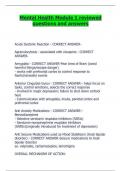Mental Health Module 1 reviewed
questions and answers
Acute Dystonic Reaction - CORRECT ANSWER-
Agranulocytosis - associated with clozapine - CORRECT
ANSWER-
Amygdala - CORRECT ANSWER-Fear Area of Brain (avoid
harmful things/escape danger)
- works with prefrontal cortex to control response to
fearful/stressful events
Anterior Cingulate Gyrus - CORRECT ANSWER-- helps focus on
tasks, control emotions, selects the correct response
- involved in major depression; failure to shut down cortisol
here
- Communicates with amygdala, insula, parietal cortex and
prefrontal cortex
Anti Anxiety Medications - CORRECT ANSWER--
Benzodiazepines
- Selective serotonin reuptake inhibitors (SSRIs)
- Serotonin-norepinephrine reuptake inhibitors
(SNRIs)(originally introduced for treatment of depression)
Anti Seizure Medications used as Mood Stabilizers (treat bipolar
disorder) - CORRECT ANSWER-Seizure medications to treat
bipolar disorder
ex. valproate, carbamazepine, lamotrigine
OVERALL MECHANISM OF ACTION:
,- decrease neuronal excitability
- inhibition of sodium channel activity
- inhibition of calcium channel activity
- enhancement of GABAergic neurotransmission pathways
- inhibition of glutamatergic neurotransmission pathways
- inhibit GSK3B like lithium
*may work on many or combo of these mechanisms
*ability to balance excitatory and inhibitory neuronal pathways
to stabilize mood
EACH MED LISTED BELOW...
1. Carbamazepine
MECHANISM OF ACTION:
- inhibit neuronal sodium channels during depolarization events
to decrease neuronal excitability
- works specifically on reducing neurons that fire
frequently/repeatedly (inappropriate excitability)
- less likely to affect normal neuron function
ADVERSE EFFECTS:
- anticholinergic effects (dry mouth, constipation, urinary
retention, blurred vision)
*S's - can't spit, shit, see, pee
- orthostatic hypotension, sedation, ataxia
- rash
NURSING CONSIDERATIONS:
- baseline lab work for liver function test, complete blood count
(CBC), electrocardiogram, electrolyte levels (to avoid toxicity
but no established therapeutic blood levels)
2. Valproate
MECHANISM OF ACTION:
,- block sodium and calcium channels
- elevate GABA levels by inhibiting degrading enzyme
ADVERSE EFFECTS:
- tremor, weight gain, sedation
*rare but serious include:
- thrombocytopenia, pancreatitis, hepatic failure
- potent teratogen
- cause hepatotoxicity
NURSING CONSIDERATIONS:
- baseline liver function, CBC before treatment (repeat
periodically)
- monitor durg level in blood for therapeutic range
3. Lamotrigine (lamictal)
MECHANISM OF ACTION:
- inhibits neuronal sodium and calcium channels
- modulates release of excitatory neurotransmitters (glutamate
and aspartate)
PROS:
- most effective maint
Area of brain that contains neural pathways to and from the
brain? - CORRECT ANSWER-
Area responsible for the regulation of sex and aggression? -
CORRECT ANSWER-Amygdala and Hypothalamus
- Anger starts with the amygdala stimulating the hypothalamus,
much like in the fear response. In addition, parts of the
prefrontal cortex may also play a role in anger. People with
damage to this area often have trouble controlling their
emotions, especially anger and aggression.
, Area which rhythmic physiological activities (breathing and
heart rate) are regulated? - CORRECT ANSWER-
Benzodiazepines - CORRECT ANSWER-ANTI ANXIETY
ex. diazepam (Valium), clonazepam (Rivotril), alprazolam
(Xanax)
INSOMNIA - hypnotic (sleep-inducing effect)
ex. lorazepam (Ativan), nitrazepam (Mogadon), oxazepam
(Serax), temazepam (Resoril), triazolam (Halcion), flurazepam
(Dalmane)
MECHANISM OF ACTION:
- enhance action of GABA by binding to receptor complex
- only have effect if GABA is also bound to binding site on
receptor complex in limbic system to decrease anxiety
- this decreases chance of overall decrease of neuronal
excitability
PROS:
- help with alcohol withdrawal symptoms (seizures) bc.
decreased overexcitability
ADVERSE EFFECTS:
- sedation at higher levels/ CNS depression!
- requires higher dose -> quickly induce tolerance ->
dependant (benzodiazepines) so switch to Buspirone (long
term) safe for addiction/alcoholism
- when used with other CNS depressants (alcohol, opioids,
tricyclic antidepressants): respiratory depression, coma, death
- affect motor ability, attention, judgement
- Ataxia
AVOID:
- working in construction, driving car




